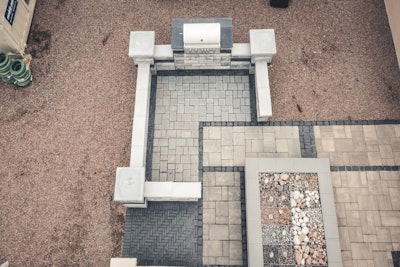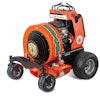
Metal edging for hardscapes is an elegant, tailored way to upgrade your outdoor living spaces. It looks clean cut and is a practical solution for keeping bulk materials like decorative rock and mulch contained. Metal edging creates a transition between the lawn and garden bed. All of these factors upgrade property value and style. While hardscaping is not the cheapest option, it is timeless and does a great job of guarding beds and protecting customer's landscape investment.
Tools needed for metal edging:
- Mallet
- Tamper
- Metal snips
- Protective gloves for installation
- Hacksaw
- Long-handled pliers
- Sharp shooter spade to dig a trench in hard soils
 An example of metal edging.SiteOne
An example of metal edging.SiteOne
Benefits to metal edging
Edging creates separation between landscape beds, grass, paths and driveways without taking up valuable surface space. This prevents migration of materials like gravel, mulch, pavers, stone and stops grass from creeping over beds and paths. The edging does not rot or chip as it is durable and strong. Metal edging fits into many landscape styles and is easy to install and maintain. It also resists ground movement from inclement weather such as frost or excessive rains and damage from lawn maintenance like string trimmers. Metal edging is flexible and can fit any new landscape bed changes. It is available in multiple heights for a wide variety of applications.
Steel edging
Steel edging is a strong and rigid option for your project. It is thin but holds its shape well under large loads and will not bend under pressure from car tires on a gravel driveway and has a very slow rate of corrosion. While painted steel edging is a classic option, Corten steel is gaining popularity. When Corten steel is untreated, it looks silver at first and then develops a rust-colored patina. Many people like this color for the aesthetic purposes. The oxidized “rust” acts as a protective coating of the interior of the metal strips. If this is not the desired aesthetic, painted options like enamel dipped or powder coated edging are available to prevent rust.
Typically steel edging is available in 10-foot and 16-foot lengths. Most professional landscape installations use products 1/8-inch thick or greater.
Aluminum edging
Aluminum is a lighter weight material, and it’s easier to handle and transport than steel. Heavy gauge aluminum also does not rust. It is softer and bends easier than steel, so choose an option that is 1/8 inch to 1/4 inch thick to prevent unintended bending. This metal also needs to be installed deeper than steel. It’s recommended to leave only about a half inch above ground, or it could be damaged by mowers.
Most aluminum edging requires stakes to further stabilize the metal. This kind of metal is better for curvaceous installations. It is typically available in 8-foot and 16-foot lengths.
About installations
Metal edging is available mostly in long strips typically eight to ten feet that have overlapping connections. Strip heights vary and run three to five inches high. The height chosen will depend on how much the customer wants protruding above the soil. Some metal edging comes with built in anchors or slots for stakes for easier installation. Be sure to check manufacturer installation recommendations as steel and aluminum have slightly different recommendations for installation.















![Doosan Bobcat Wacker Neuson Stack 2ec Js Pb V6e[1]](https://img.greenindustrypros.com/mindful/acbm/workspaces/default/uploads/2025/12/doosan-bobcat-wacker-neuson-stack2ecjspbv6e1.CPyyz8ubHn.png?ar=16%3A9&auto=format%2Ccompress&bg=fff&fill-color=fff&fit=fill&h=135&q=70&w=240)





